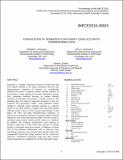Formulation of Seawater Flow Exergy Using Accurate Thermodynamic Data
Author(s)
Sharqawy, Mostafa H.; Zubair, Syed M.; Lienhard, John H
DownloadIMECE2010-40915.pdf (208.5Kb)
PUBLISHER_POLICY
Publisher Policy
Article is made available in accordance with the publisher's policy and may be subject to US copyright law. Please refer to the publisher's site for terms of use.
Terms of use
Metadata
Show full item recordAbstract
Seawater is a complex electrolyte solution of water and salts with sodium chloride as the major constituent. However, the thermodynamic properties of seawater are considerably different from those of aqueous sodium chloride solution. In the literature, exergy analyses of seawater desalination systems have sometimes modeled seawater by sodium chloride solutions of equivalent salt content or salinity; however, such matching does not bring all important properties of the two solutions into agreement. Furthermore, some published studies attempt to represent sodium chloride solutions as a specific model for an ideal mixture of liquid water and solid sodium chloride, which is shown to have serious shortcomings. In this paper, the most up-to-date thermodynamic properties of seawater are compared with those of aqueous sodium chloride solution as well as the ideal mixture model. The flow exergy is calculated using various models and the results are compared. In addition, the minimum work required to desalinate a unit mass of fresh water from seawater of varying salinity is calculated using these models. The flow exergy calculated using the ideal mixture model in question is about 50% less than that of seawater. Accordingly, the minimum desalination work is underpredicted by about 50% when calculating it using that ideal mixture model. This consequently shows that exergy analysis and the second law efficiency calculations performed using the ideal mixture model is comparatively far from the actual values.
Date issued
2010-11Department
Massachusetts Institute of Technology. Abdul Latif Jameel World Water & Food Security Lab; Massachusetts Institute of Technology. Department of Mechanical EngineeringJournal
Volume 5: Energy Systems Analysis, Thermodynamics and Sustainability; NanoEngineering for Energy; Engineering to Address Climate Change, Parts A and B
Publisher
ASME International
Citation
Sharqawy, Mostafa H., John H. Lienhard, and Syed M. Zubair. “Formulation of Seawater Flow Exergy Using Accurate Thermodynamic Data.” Volume 5: Energy Systems Analysis, Thermodynamics and Sustainability; NanoEngineering for Energy; Engineering to Address Climate Change, Parts A and B (2010). © 2010 ASME
Version: Final published version
ISBN
978-0-7918-4429-8